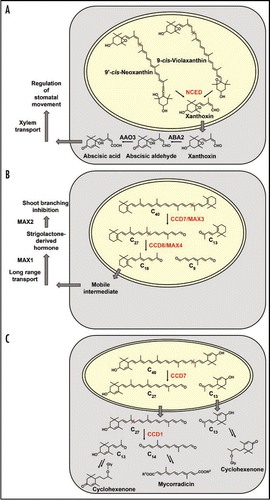Figures & data
Figure 1 Comparison of substrates, enzymes and their compartmentation in three carotenoid cleavage pathways. (A) ABA biosynthesis involves cleavage of cis-carotenoid substrates by NCEDs in the plastid, C15 xanthoxin export to the cytosol followed by further metabolization steps and transport.Citation6 (B) Strigolactone biosynthesis is assumed to start from β-carotene and to proceed via two consecutive cleavage steps (CCD7 and CCD8) inside the plastid as exemplified by the MAX3 and MAX4 proteins of Arabidopsis.Citation4 The C18 cleavage product of CCD8 or a derivative of it is predicted to serve as mobile strigolactone precursor undergoing export to the cytosol, further modification steps, transport and eventually perception as a regulator of shoot branching.Citation7 (C) Proposed organization of local C13 and C14 apocarotenoid biosynthesis in a mycorrhizal root cell. Lactucaxanthin as the tentatively proposed C40 carotenoid precursor containing two α-ionone rings is tailored by two consecutive cleavage steps in the plastid (CCD7) and subsequently, following export of the C27 intermediate, in the cytosol (CCD1). The C27 intermediate has only been detected upon silencing CCD1 expression.Citation5 Additional modification steps in the cytosol lead to the various C13 cyclohexenone and C14 mycorradicin derivatives accumulating in mycorrhizal roots. Abbreviations: MAX, more axillary branching; Gly, glycoside.
